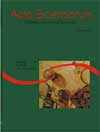<b>Civilizations decadence and ideals memory: the history philosophy in Raul Pompéia’s work</b> - DOI: 10.4025/actascihumansoc.v25i2.2171
Abstract
The present work analyses the conception of History in Raul Pompéia’s work and the role attributed to the memory. To that, we have chosen as corpus the chronicle Cavaleiros Andantes (Wandering Knights), Professor Claudio’s second conference in O Ateneu (The High School) and the work Canções sem metro (Songs without metric), as we find a great narrative of the humanity in them, which makes possible to recognize a History Philosophy from it. Against the dominant ideologies at the end of the XIX century, we realise a reaction to the positive idea of progress, which is expressed in a decadentist and cyclic vision of History, whose eschatology without gods leads us, after the final cataclysm, to the stainless time of origin. However, despite the pessimism of the system, the repressed desire of the revolutionary rupture is latent in it and is able to rend the infernal cycle. The task of recording the tragedy of the ideals with the probable aim of keeping this flame alive is given to the artist. so it is to the historianDownloads
Download data is not yet available.
Published
2008-04-15
How to Cite
Silva, M. L. e. (2008). <b>Civilizations decadence and ideals memory: the history philosophy in Raul Pompéia’s work</b> - DOI: 10.4025/actascihumansoc.v25i2.2171. Acta Scientiarum. Human and Social Sciences, 25(2), 201-210. https://doi.org/10.4025/actascihumansoc.v25i2.2171
Issue
Section
Literature and Linguistics
DECLARATION OF ORIGINALITY AND COPYRIGHTS
I Declare that current article is original and has not been submitted for publication, in part or in whole, to any other national or international journal.
The copyrights belong exclusively to the authors. Published content is licensed under Creative Commons Attribution 4.0 (CC BY 4.0) guidelines, which allows sharing (copy and distribution of the material in any medium or format) and adaptation (remix, transform, and build upon the material) for any purpose, even commercially, under the terms of attribution.
Read this link for further information on how to use CC BY 4.0 properly.























